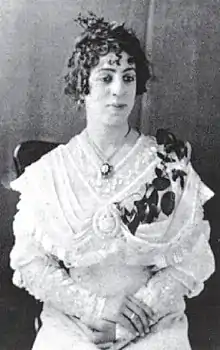Peyveste Hanım
Peyveste Hanım (Ottoman Turkish: پیوسته خانم; born Princess Rabia Emuhvari; 10 May 1873 – c. 1943) was the eleventh wife of Sultan Abdul Hamid II of the Ottoman Empire.
| Peyveste Hanım | |||||
|---|---|---|---|---|---|
 | |||||
| Born | Rabia Emuhvari 10 May 1873 Pitsunda, Georgia, Russian Empire | ||||
| Died | c. 1943 (aged 69–70) Mourad Boulevard, Paris, France | ||||
| Burial | Bobigny cemetery, Paris | ||||
| Spouse | |||||
| Issue | Şehzade Abdurrahim Hayri | ||||
| |||||
| House | Emkhaa (by birth) Ottoman (by marriage) | ||||
| Father | Osman Emkhaa | ||||
| Mother | Hesna Çaabalurhva | ||||
| Religion | Sunni Islam | ||||
Early life
Peyveste Hanım was born on 10 May 1873 in Pitsunda, Abkhazia. Born as Rabia Eymhaa, she was a member of Abkhazian princely family Emuhvari. Her father was Prince Osman Bey Eymhaa, and her mother was Princess Hesna Hanım Çaabalurhva, an Abkhazian.[1] She had an elder brother, Prince Ahmed Pasha, and three elder sisters, Princess Eda Hanım (died 1930), Princess Nurhayat Hanım (died 1939), and Princess Mahşeref Hanım (1871 – 1920).[2] She was maternal first cousin of Filizten Hanım, wife of Sultan Murad V.[3]
In 1877, Osman Bey volunteered for service in the Russo-Turkish War (1877–1878). He took his wife and children to Istanbul, and entrusted them to the care of Hesna Hanım's paternal cousin, Davud Bey. He returned to Abkhazia and was killed in the war.[4]
Davud Pasha's wife Meryem Hanım, who had been in service in the palace, decided to present the widowed Hesna Hanım and her daughters to her paternal cousin Nazikeda Kadın, first wife of Sultan Abdul Hamid.[5] Nazikeda won over Hesna, and adopted her daughters.[6]
Marriage

Peyveste met Abdul Hamid in 1890, and married him on 24 January 1893 in the Yıldız Palace.[1] She was given the title of "Third Fortunate".[7]
On 14 August 1894,[8] a year after the marriage, she gave birth to her only son, Şehzade Abdurrahim Hayri. Upon his birth, she was presented with a beautiful apartment. In 1897, Peyveste became pregnant with her second child, however, suffered an abortion.[9] Abdul Hamid later allocated her in one of the Kiosks on the gardens of the Yıldız Palace.[10]
On 27 April 1909, Abdul Hamid was deposed, and sent into exile in Thessaloniki.[11] Peyveste was closed to Abdul Hamid. She and her son accompanied him for some time, and returned to Istanbul in 1910.[7] She bought a mansion in Büyükdere Avenue, Şişli,[12] and took along Sazkar Hanım.[13] Peyveste and Sakzar's rooms were located on the same floor. Their daily routine was to drink coffee with each other, and to talk about old times.[13]
After Thessaloniki fell to Greece in 1912, Abdul Hamid also returned to Istanbul, and settled in the Beylerbeyi Palace, where he died in 1918.[14]
Widowhood and death
After Abdul Hamid's death, she settled in the Sadaret Mansion located in Sultanahmet, Fatih.[15] On 30 May 1918, Peyveste met with the Empress Zita of Bourbon-Parma in the harem of Yıldız Palace, when the latter visited Istanbul with her husband Emperor Charles I of Austria.[16]
At the exile of the imperial family in March 1924, Peyveste accompanied her son to Paris.[2] On 14 January 1925, she gave the power of attorney to Sami Günzberg, a well-known Turkish Jewish lawyer, authorising him to regain from usurpers buildings, lands, mines, concessions left by Abdul Hamid situated in Turkish territory and elsewhere.[17]
She had sold her mansion in Şişli, and from the money she received, they lived a comfortable life in an apartment on Mourad Boulevard.[12] She died in 1943, and was buried in Bobigny cemetery, Bobigny, Paris.[2]
Issue
| Name | Birth | Death | Notes |
|---|---|---|---|
| Şehzade Abdurrahim Hayri | 14 August 1894[18][7] | 2 January 1952[18][7] | married twice, and had issue, one daughter |
References
- Açba 2007, p. 144.
- Açba 2007, p. 146.
- Açba 2007, p. 114.
- Açba 2004, p. 23.
- Açba 2004, p. 23-4.
- Açba 2004, p. 25.
- Uluçay 2011, p. 250.
- Bey, Mehmet Sürreya (1969). Osmanlı devletinde kim kimdi, Volume 1. Küğ Yayını. p. 125.
- Açba 2004, p. 28.
- Açba 2004, p. 29.
- Hall, Richard C. (9 October 2014). War in the Balkans: An Encyclopedic History from the Fall of the Ottoman Empire to the Breakup of Yugoslavia. ABC-CLIO. pp. 1–2. ISBN 978-1-610-69031-7.
- "AZ KALSIN HALİFE OLACAKTI". ekrembugraekinci.com. 22 August 2012. Retrieved 12 January 2021.
- Açba 2007, p. 145.
- Parry, Milman; Lord, Albert B. (1979). Serbocroation heroic songs, Volume 1. Harvard University Press. p. 371.
- Akyıldız, Ali (2018). Son Dönem Osmanlı Padişahlarının Nikâh Meselesi. p. 701.
- Açba 2004, p. 56.
- Kark, Ruth; Frantzman, Seth J. (2010). "One of the most spectacular lawsuits ever launched": Abdülhamid's heirs, his lands and the land case in Palestine, 1908-1950. p. 138.
- Osmanoğlu 2000, p. 263.
Sources
- Uluçay, M. Çağatay (2011). Padişahların kadınları ve kızları. Ötüken. ISBN 978-9-754-37840-5.
- Açba, Harun (2007). Kadın efendiler: 1839-1924. Profil. ISBN 978-9-759-96109-1.
- Açba, Leyla (2004). Bir Çerkes prensesinin harem hatıraları. L & M. ISBN 978-9-756-49131-7.
- Osmanoğlu, Ayşe (2000). Babam Sultan Abdülhamid. Mona Kitap Yayinlari. ISBN 978-6-050-81202-2.
- Sakaoğlu, Necdet (2008). Bu Mülkün Kadın Sultanları: Vâlide Sultanlar, Hâtunlar, Hasekiler, Kandınefendiler, Sultanefendiler. Oğlak Yayıncılık. ISBN 978-6-051-71079-2.
- The Concubine, the Princess, and the Teacher: Voices from the Ottoman Harem. University of Texas Press. 2010. ISBN 978-0-292-78335-5.
_p259_Sultan_Abdul_Hamid_II.jpg.webp)
.svg.png.webp)